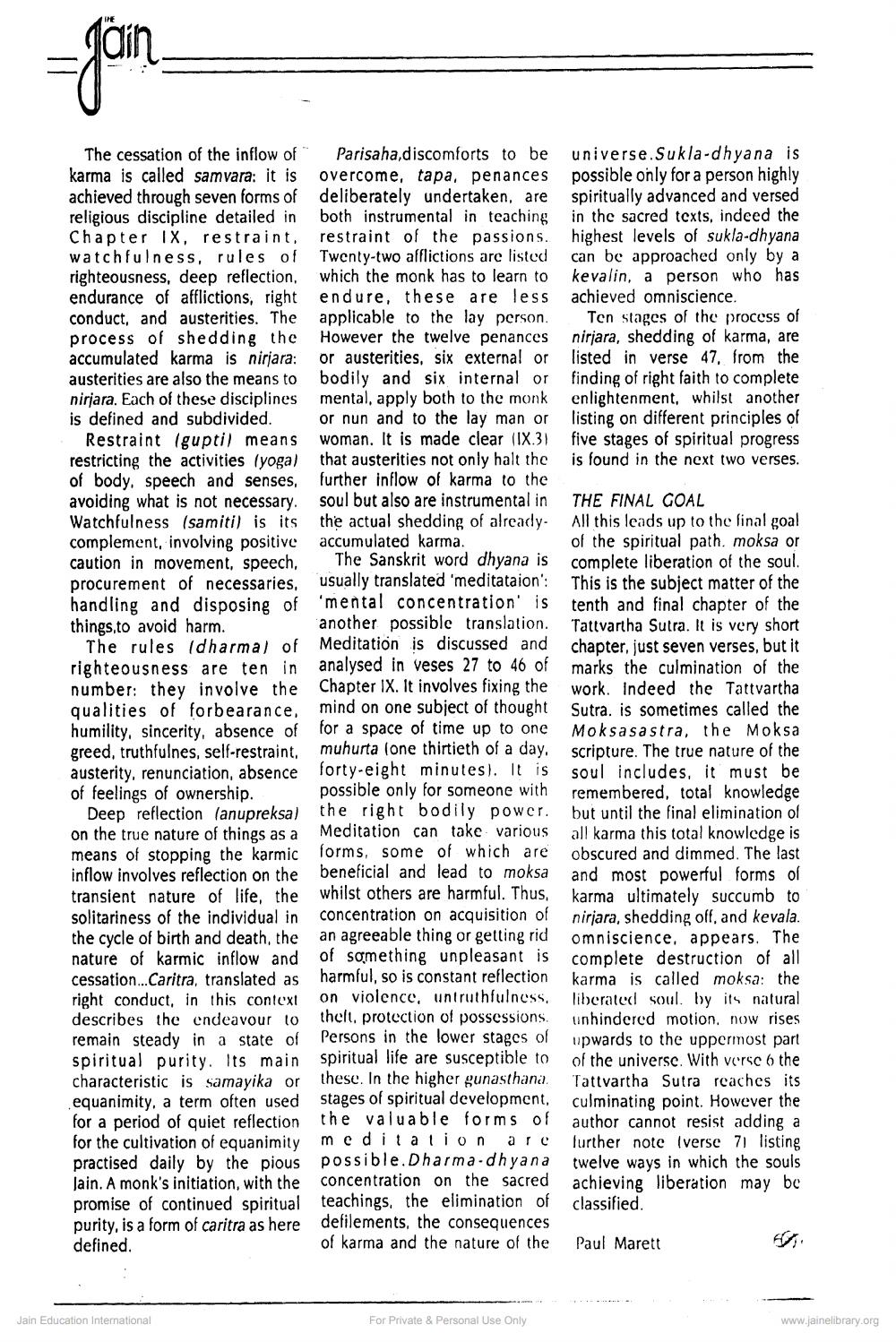Book Title: Jain Literature Author(s): Paul Marett Publisher: ZZZ Unknown View full book textPage 9
________________ S . The cessation of the inflow of Parisaha,discomforts to be universe.Sukla-dhyana is karma is called samvara: it is overcome, tapa, penances possible only for a person highly achieved through seven forms of deliberately undertaken, are spiritually advanced and versed religious discipline detailed in both instrumental in teaching in the sacred texts, indeed the Chapter IX, restraint, restraint of the passions. highest levels of sukla-dhyana watchfulness, rules of Twenty-two afflictions are listed can be approached only by a righteousness, deep reflection, which the monk has to learn to kevalin, a person who has endurance of afflictions; right endure, these are lesS achieved omniscience. conduct, and austerities. The applicable to the lay person. Ton stages of the process of process of shedding the However the twelve penances nirjara, shedding of karma, are accumulated karma is nirjara: or austerities, six external or listed in verse 47, from the austerities are also the means to bodily and six internal or finding of right faith to complete nirjara. Each of these disciplines mental, apply both to the monk enlightenment, whilst another is defined and subdivided. or nun and to the lay man or listing on different principles of Restraint (gupti) means woman. It is made clear (IX.31 five stages of spiritual progress restricting the activities (yoga) that austerities not only halt the is found in the next two verses. of body, speech and senses, further inflow of karma to the avoiding what is not necessary. soul but also are instrumental in THE FINAL GOAL Watchfulness (samiti) is its the actual shedding of already. All this leads up to the final goal complement, involving positive accumulated karma. of the spiritual path. moksa or caution in movement, speech, The Sanskrit word dhyana is complete liberation of the soul. procurement of necessaries, usually translated 'meditataion': This is the subject matter of the handling and disposing of 'mental concentration' is tenth and final chapter of the things, to avoid harm. another possible translation. Tattvartha Sutra. It is very short The rules (dharmal of Meditation is discussed and chapter, just seven verses, but it righteousness are ten in analysed in veses 27 to 46 of marks the culmination of the number: they involve the Chapter IX. It involves fixing the work. Indeed the Tattvartha qualities of forbearance, mind on one subject of thought Sutra. is sometimes called the humility, sincerity, absence of for a space of time up to one Moksasastra, the Moksa greed, truthfulnes, self-restraint, muhurta (one thirtieth of a day. Scripture. The true nature of the austerity, renunciation, absence forty-eight minutes). It is soul includes, it must be of feelings of ownership. possible only for someone with remembered, total knowledge Deep reflection (anupreksa) the right bodily power. but until the final elimination of on the true nature of things as a Meditation can take various all karma this total knowledge is means of stopping the karmic forms, some of which are obscured and dimmed. The last inflow involves reflection on the beneficial and lead to moksa and most powerful forms of transient nature of life, the whilst others are harmful. Thus, karma ultimately succumb to solitariness of the individual in concentration on acquisition of nirjara, shedding off, and kevala. the cycle of birth and death, the an agreeable thing or getting rid omniscience, appears. The nature of karmic inflow and of something unpleasant is complete destruction of all cessation...Caritra, translated as harmful, so is constant reflection karma is called moksa: the right conduct, in this context on violence, untruthfulness, liberated soul. by its natural describes the endeavour 10 thell. protection of possessions. Unhindered motion, now rises remain steady in a state of Persons in the lower stages of upwards to the uppermost part spiritual purity. Its main spiritual lite are susceptible to of the universe. With versc 6 the characteristic is Samayika or these. In the higher gunasthana Tattvartha Sutra reaches its equanimity, a term often used stages of spiritual development, culminating point. However the for a period of quiet reflection the valuable forms of author cannot resist adding a for the cultivation of equanimity medication are further note (verse 71 listing practised daily by the pious possible. Dharma-dhyana twelve ways in which the souls Jain. A monk's initiation, with the concentration on the sacred achieving liberation may be promise of continued spiritual teachings, the elimination of classified. purity, is a form of caritra as here defilements, the consequences defined. of karma and the nature of the Paul Marett Jain Education International For Private & Personal Use Only www.jainelibrary.orgPage Navigation
1 ... 7 8 9
